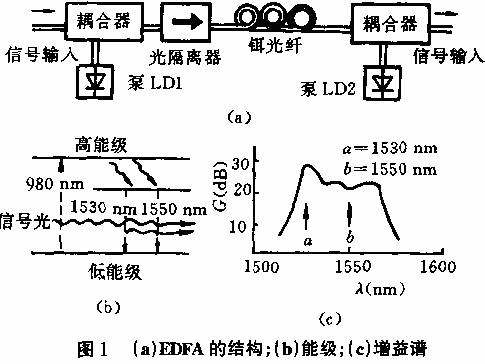There are three main categories of optical amplifiers:
(1) Semiconductor Optical Amplifier (SOA, Semiconductor Optical Amplifier);
(2) Fiber amplifiers doped with rare earth elements (erbium Er, thulium Tm, praseodymium Pr, rubidium Nd, etc.), mainly erbium-doped fiber amplifiers (EDFA), thulium-doped fiber amplifiers (TDFA) and praseodymium-doped fiber amplifiers (PDFA) )wait;
(3) Nonlinear fiber amplifier, mainly fiber Raman amplifier (FRA, Fiber Raman Amplifier). The main performance comparison of these optical amplifiers is shown in the table

EDFA (erbium-doped fiber amplifier)
Quartz fiber doped with rare earth elements (such as Nd, Er, Pr, Tm, etc.) can form a multi-level laser system, which directly amplifies the input signal light under the action of pump light. After providing appropriate feedback, a fiber laser is formed. The operating wavelengths of Nd-doped fiber amplifiers are 1060nm and 1330nm. Due to deviation from the optimal sink for optical fiber communications and other reasons, its development and application are limited. The working wavelengths of EDFA and PDFA are respectively in the minimum loss (1550nm) and zero dispersion wavelength (1300nm) windows of optical fiber communication. TDFA works in the S-band, both of which are very suitable for optical fiber communication system applications. In particular, EDFA has developed the fastest and has been put into practical use.
The principle of EDFA
The basic structure of EDFA is shown in Figure 1(a). It mainly consists of active media (erbium-doped quartz optical fiber about tens of meters long, core diameter 3-5 microns, doping concentration (25-1000)x10-6) , pump light source (990 or 1480nm LD), optical coupler and optical isolator. Signal light and pump light can propagate in the same direction (co-directional pumping), opposite directions (reverse pumping), or both directions (bidirectional pumping) in the erbium fiber. When the signal light and the pump light are injected into the erbium fiber at the same time, the erbium ions are excited to a high energy level under the action of the pump light (Figure 1 (b), three-level system), and quickly decay to the metastable energy level. , when it returns to the ground state under the action of the incident signal light, it emits photons corresponding to the signal light, so that the signal is amplified. Figure 1 (c) is an amplified spontaneous emission (ASE) spectrum with a large bandwidth (up to 20-40nm) and two peaks corresponding to 1530nm and 1550nm respectively.
The main advantages of EDFA are high gain, large bandwidth, high output power, high pump efficiency, low insertion loss, and insensitivity to polarization state.

Problems with optical amplifiers
Although the optical amplifier (especially EDFA) has many outstanding advantages, it is not an ideal amplifier. In addition to the additional noise that reduces the SNR of the signal, there are also some other shortcomings, such as:
•Unflattened gain spectrum within the amplifier bandwidth affects multi-channel amplification performance;
•When optical amplifiers are used in cascades, the effects of ASE noise, fiber dispersion and nonlinear effects will accumulate.
These issues must be considered in application and system design.
Application of optical amplifiers in optical fiber communication systems

In optical fiber communication systems, optical amplifiers can be used as power boost amplifiers for transmitters to increase transmission power, and as preamplifiers for receivers to improve reception sensitivity. They can also replace traditional optical-electrical-optical repeaters. , extend the transmission distance and realize all-optical communication.
In optical fiber communication systems, the main factors limiting transmission distance are fiber loss and dispersion. Using a narrow spectrum line light source or working near a zero-dispersion wavelength, the impact of fiber dispersion will be smaller. This system does not require complete signal timing regeneration at each relay station (3R relay). It is enough to directly amplify the optical signal with an optical amplifier (1R relay). Optical amplifiers can be used not only in long-distance trunk systems, but also in optical fiber distribution networks, especially in WDM systems, for simultaneous amplification of multiple channels.
1) Application of optical amplifiers in trunk optical fiber communication systems
Figure 2 shows the application of optical amplifiers in trunk optical fiber communication systems. (a) In the figure, an optical amplifier is used as the transmitter power boost amplifier and receiver preamplifier, doubling the non-relay distance. For example, using EDFA, the transmission distance of a 1.8Gb/s system increases from 120km to 250km or even 400km. Figure 2 (b)-(d) shows the application of optical amplifiers in multi-relay systems; Figure (b) shows the traditional 3R relay method; Figure (c) shows the hybrid relay method of 3R repeaters and optical amplifiers; Figure (d) is an all-optical relay method; in an all-optical communication system, it does not include timing and regeneration circuits, so it is bit-penetrating and has no "electronic whiskers" restrictions. As long as the sending and receiving equipment at both ends is replaced, It is easy to upgrade from low speed to high speed without replacing the optical amplifier.
2) Application of optical amplifiers in optical fiber distribution networks

The high power output advantage of optical amplifiers (especially EDFA) is very useful in broadband distribution networks (such as CATV networks). The traditional CATV network uses coaxial cables and is amplified every few hundred meters. The service radius of the network is about 7km. Optical fiber CATV networks using optical amplifiers can not only greatly increase the number of allocated users, but also greatly expand the network diameter. Recent developments have shown that hybrid fiber optic/co-cable (HFC) distribution takes the best of both worlds and is highly competitive.
 The Difference Between AX1800 ONU and AX3000 ONU
The Difference Between AX1800 ONU and AX3000 ONU
 How are Huawei OLTs Classified?
How are Huawei OLTs Classified?
 The Future Trend of Optical Line Terminals (OLTs)
The Future Trend of Optical Line Terminals (OLTs)
 The Difference Between ONU and ONT
The Difference Between ONU and ONT